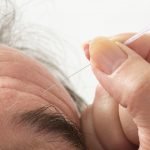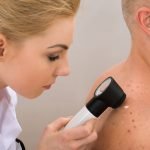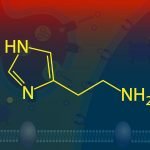Acne During Pregnancy: Safe Approaches to Treatment
Katie Rose, NMD
The management of acne during pregnancy poses a challenge to many practitioners, due to the fact that many over-the-counter and prescription medications are contraindicated as a result of the high risk of birth defects. Rather than focusing on treating the acne superficially with creams and gels, or using potentially harmful medications that ultimately suppress the manifestations of underlying imbalances, we can safely address lifestyle and nutrition, and consider energetic and light therapies to stimulate healing.Statistics show that over 50% of women develop acne vulgaris during pregnancy.1 During the 1st trimester, increased hormone levels lead to an increase in the skin’s natural oils, otherwise known as sebum. This increased sebum production, along with the build-up of dead skin cells, creates a perfect feeding ground for the bacteria that cause acne, Proprionibacterium acnes. While the development of acne is a good sign that a woman’s hormone levels are heading in the right direction to support a healthy pregnancy, it can be an added stressor for women who are already struggling with an ever-changing pregnancy body. Women are at higher risk of developing acne during pregnancy if they have a prior history of acne and if their previous acne flared at the start of a menstrual cycle, signaling a hormonal connection.1
Contraindicated Treatments
Prescription oral medications for acne that are contraindicated during pregnancy include isotretinoin1-3 and other retinoids, anti-androgen medications (spironolactone and flutamide), and oral tetracyclines (doxycycline, minocycline, and tetracycline). Isotretinoin is associated with increased risk of miscarriage, premature birth, and birth defects, including cleft palate, congenital heart defects, hydrocephalus, and microcephaly.4 Oral retinoids have been classified by the US Food & Drug Administration (FDA) as pregnancy category X,5 meaning they have been associated with fetal abnormalities or positive evidence of human fetal risk, with the risks clearly outweighing the benefits.
Anti-androgenic drugs, commonly used for the treatment of acne in polycystic ovarian syndrome (PCOS) are associated with feminization of male fetuses early in pregnancy, as well as potential endocrine dysfunction in both male and female fetuses, which can persist into adulthood. Most anti-androgenic drugs have been assigned to pregnancy category D5 by the FDA, indicating that positive evidence of human fetal risk has been shown but that potential benefits may outweigh risks in some cases. Antibiotics in the tetracycline class have also been categorized as level D by the FDA, due to the risk of inhibition of fetal bone growth, as well as discoloration of teeth. Topical applications commonly used for acne that should be avoided in pregnancy include topical retinoids such as tretinoin. Although the absorption of these products is low, there is still a concern of birth defects with topical retinoids. Common drug-free options for the treatment of acne that should be avoided during pregnancy is intense pulsed light (IPL), as well as laser. There are no studies to indicate whether the fetus is at risk during these procedures; however, due to hormonal changes that can result in increased skin pigmentation, such as melasma, IPL and laser should be avoided during pregnancy and for several months following delivery.
Possibly Safe Treatments
Although the following treatments are considered to be potentially safe during pregnancy, they still do not address the root cause of acne during pregnancy and carry potential risks. FDA pregnancy categories B and C are included in this group. Pregnancy category B drugs are ones for which animal studies show no risk, or adverse fetal effects, but for which controlled human 1st-trimester studies are either not available or do not confirm risk.5 Drugs in category B show no evidence of 2nd or 3rd-trimester risk. Medications in this category that are commonly used to treat acne include oral erythromycin, topical clindamycin, and topical azelaic acid. With pregnancy category C drugs,4 animal studies show adverse fetal effects, but there are no controlled human studies available to confirm human risk. These medications include topical benzoyl peroxide and topical salicylic acid.
Naturopathic Approaches
Ideally, a woman would seek prenatal counseling from a holistic practitioner 2 to 4 months before deciding to conceive. During this time, the practitioner can help regulate the patient’s hormone levels, cleanse the blood, liver, and lymph, heal the gut, and identify food and environmental sensitivities that may increase a woman’s risk of developing acne. If acne develops during pregnancy, several areas need to be addressed.
Lifestyle Considerations
First, proper hydration must be ensured, especially if morning sickness is preventing the patient from drinking enough fluids. Women should aim for a minimum of eight 8-oz glasses per day of filtered or purified water, plus one 8-oz cup for each hour of light activity. Diluted juices and herbal teas, such as ginger and chamomile, count toward this intake and may also help to curb morning sickness. Sodas and sugar-based juices should be avoided, as sugar is a common trigger for acne. Stress and lack of sleep are also reported triggers for acne. Encouraging women to meditate, participate in light-to-moderate exercise (30 min per day is recommended), and experiment with sleep positions and pillows can be helpful in addressing these factors. Proper hygiene should also be considered. Skin care regimen should include a gentle non-soap-based cleanser that is paraben-, phthalate-, and sulfate-free, a gentle toner (water-based with rosemary, grape seed, or green tea extract), and a simple moisturizer, such as jojoba or coconut oil. Women should also replace face towels and pillowcases regularly, a minimum of twice weekly to prevent spreading the acne-causing bacteria. Touching the face and popping pimples should also be strictly avoided in order to prevent spreading bacteria and increasing the risk of scarring. Furthermore, scrubbing the face and overwashing can irritate sensitive skin by depleting natural oils, sending the sebum production into overdrive and potentially worsening acne.
Nutrition Considerations
A balanced diet of clean protein, complex carbohydrates, healthy fats, and lots of vegetables and fruit is ideal during pregnancy. However, between nausea, food aversions, and food cravings, getting a balanced diet can be challenging. Common food triggers for acne include sugar, saturated fats, chocolate, dairy, and gluten, although other sensitivities, such as eggs, nuts, soy, and corn are also possible and can be identified either through elimination diet or IgG testing. Generally speaking, those with diets higher in fruits and vegetables are linked with a lower incidence of acne, likely due to increased levels of antioxidants. Nutrient deficiencies should also be considered, especially zinc, vitamin A, vitamin C, and omega-3 fatty acids. Getting these nutrients from food sources is the safest option, but a prenatal vitamin should also be used, ideally even before conception.
Zinc
While the exact mechanism is unknown, zinc is likely helpful in treating acne by regulating hormonal balance, carrying vitamin A to the skin, and facilitating apoptosis, which prevents dead skin cells from sticking together; zinc is also necessary for the healthy renewal of skin cells. According to the Mayo Clinic, the recommended daily allowance (RDA) for zinc in pregnancy is 12 mg per day6; however, a systematic review of the literature7 shows that use of supplemental zinc at higher levels than this is not harmful during pregnancy. Foods high in zinc that are safe to eat during pregnancy include beef and lamb, chicken and pork, spinach, and sunflower seeds. If a zinc deficiency is suspected or confirmed, supplemental zinc in the form of zinc picolinate can be used under the supervision of a physician, at doses of 10-15 mg per day.
Vitamin A
Vitamin A is known to help stimulate the growth of new skin cells and shedding of dead skin cells that would otherwise clog pores. Supplementation of vitamin A is not recommended in high doses during pregnancy, due to the potential for birth defects.5 However, getting the RDA of vitamin A from the diet and a prenatal vitamin can be helpful in keeping skin clear and is necessary for healthy fetal development,8 particularly lung maturation. The RDA for vitamin A during pregnancy is 750 IU/day. Most good-quality prenatal vitamins contain vitamin A in the form of natural beta-carotene (provitamin A), which is considered to be much safer in pregnancy (RDA 5000 IU). The richest sources of beta-carotene are yellow, orange, and leafy green vegetables and fruits.
Vitamin C
Vitamin C is known for strengthening the lining of capillaries, stabilizing collagen formation, and modulating the inflammation cascade, all of which can help decrease the severity of acne.9 The safest and most effective way to consume vitamin C during pregnancy is in its natural form. Fruits and vegetables that are rich in vitamin C include papaya, bell peppers, broccoli, Brussels sprouts, oranges, strawberries, kiwi, and cantaloupe. Vitamin C can also be used topically, with the most stable form being magnesium ascorbyl phosphate (MAP).9 Creams containing MAP can be applied up to TID. Side effects are rare and include stinging, erythema, and dryness. During pregnancy, when skin is often more sensitive than usual, it is recommended that women apply a small amount to a test area on the neck and wait 2 to 3 days before applying to the whole face, to ensure no adverse reactions occur.
Omega-3 Fatty Acids
Omega-3 fatty acids are known to be highly anti-inflammatory. One mechanism of action is the inhibition of leukotriene B4 (LTB4), an inflammatory cytokine associated with upregulation of sebum production.10,11 It is not purely the deficiency of omega-3s that contribute to poor skin health; rather, it is the increased ratio of inflammatory omega-6 fats to omega-3 fats. From a dietary standpoint, pregnant women with acne should try to reduce consumption of omega-6 fatty acids by avoiding cottonseed oil, corn oil, soybean oil, safflower oil, and deep-fried and processed foods. To increase dietary intake of omega-3 fatty acids, women should increase consumption of wild-caught salmon, walnuts, avocado, and chia seeds. There is some evidence that omega-3 supplementation can improve acne. In 1 double blind, placebo-controlled study, participants given 2000 mg omega-3 fatty acids daily were found to have a significant reduction of lesions in mild to moderate acne, and with no adverse reactions.12
Energetic Medicine
Acupuncture & Homeopathy
Acupuncture and homeopathy are great ways to address specific symptoms and patterns, and are both considered to be generally safe during pregnancy when practiced by a licensed professional. Acupuncture can be used to treat nausea (an underlying cause of acne-related malnutrition) and insomnia, and has been shown to decrease inflammation and improve microcirculation.13,14 A randomized, placebo-controlled study showed that after 12 sessions of acupuncture, subjects experienced a significant reduction in moderate acne lesions and an improvement in quality of life.15 Researchers concluded, in a 2009 review of 17 papers, that acupuncture and moxibustion was more effective than routine Western treatments.16
When using homeopathy, general and mental symptoms can be used along with acne location, severity, and triggers, to determine the best remedy. A thorough case should be taken, and often a constitutional remedy can be used prior to or with an acute remedy to bolster the patient; frequently, it is the constitutional that will clear the lesions if given enough time. Some of the strongest remedies in the rubric for acne vulgaris include Aurum, Carbo veg, Causticum, Hepar sulph, Nux vomica, Sepia, and Silicea. Pulsatilla cannot be discounted as a remedy best used for acne that has a clear hormonal onset.
Light-Emitting Diode (LED)
Light-emitting diode (LED) therapy has become a popular non-chemical treatment for acne vulgaris. Many dermatologists will use LED in combination with a UV-sensitizing chemical called levulin, the combination termed “photodynamic therapy.” While this is a safe and effective treatment for the general population, the use of levulin has not been studied in pregnancy and is therefore not recommended. LED alone, however, is safe for use during pregnancy. LED can treat acne by stimulating collagen formation, decreasing inflammation, and killing bacteria.17,18 Red light therapy is known to penetrate more deeply than blue light. Wavelengths in the 600-650 nanometer (nm) range have been shown to stimulate fibroblast activity, leading to upregulation of collagen production.17 Red light may also modulate cytokine activity, thereby decreasing local inflammation. Blue light therapy is especially effective against P acnes, as this bacterium produces a porphyrin that is stimulated by the blue light in wavelengths 400-420 nm, causing photo-excitation, singlet oxygen production, and bacterial destruction.17 Frequent treatments are recommended; one study showed that alternating blue and red light therapy daily for 4 weeks resulted in a 69% reduction of acne 8 weeks after the treatment course.18
The Takeaway
There are many safe treatment options for acne during pregnancy, thus pregnant women with acne should not lose hope. Women should always consult their obstetrician, naturopathic doctor, or midwife before trying any new products for acne, and seeking a second opinion is worthwhile if an initial recommendation could put mother or fetus at risk.
 Katie Rose, NMD, is a graduate of the Southwest College of Naturopathic Medicine, and an associate physician at Nature Medica Detox Spa and Naturopathic Clinic in Tucson, Arizona. Dr Rose has a focus in women’s health, pediatrics, and dermatology, and believes that the goal of all naturopathic treatments should be to assist the body in healing itself.
Katie Rose, NMD, is a graduate of the Southwest College of Naturopathic Medicine, and an associate physician at Nature Medica Detox Spa and Naturopathic Clinic in Tucson, Arizona. Dr Rose has a focus in women’s health, pediatrics, and dermatology, and believes that the goal of all naturopathic treatments should be to assist the body in healing itself.
References
- WebMD. Acne During Pregnancy. Reviewed July 12, 2013. WebMD Web site. http://www.webmd.com/skin-problems-and-treatments/acne/acne-during-pregnancy-treatments-causes. Accessed January 12, 2016.
- American Pregnancy Association. Acne During Pregnancy. Last updated July 2015. APA Web site. http://americanpregnancy.org/pregnancy-health/acne-during-pregnancy/. Accessed January 12, 2016.
- Kong YL, Tey HL. Treatment of acne vulgaris during pregnancy and lactation. Drugs. 2013;73(8):779-787.
- March of Dimes. Isotretinoin and other retinoids during pregnancy. Last reviewed July 2014. March of Dimes Web site. http://www.marchofdimes.org/pregnancy/isotretinoin-and-other-retinoids-during-pregnancy.aspx#. Accessed January 12, 2016.
- Gunatilake R, Patil AS. Drugs in Pregnancy. Reviewed January 2013. Merck Manual Web site. http://www.merckmanuals.com/professional/gynecology-and-obstetrics/drugs-in-pregnancy/drugs-in-pregnancy. Accessed January 15, 2016.
- Mayo Clinic. Zinc: Safety. Last updated November 1, 2013. Mayo Clinic Web site. http://www.mayoclinic.org/drugs-supplements/zinc/safety/hrb-20060638. Accessed January 12, 2016.
- Dreno B, Blouin E. Acne, pregnancy women and zinc salts: a literature review. Ann Dermatol Venereol. 2008;135(1):27-33. [Article in French]
- Strobel M, Tinz J, Biessalsk HK. The importance of beta-carotene as a source of vitamin A with special regard to pregnant and breastfeeding women. Eur J Nutr. 2007;46 Suppl 1:1-20.
- Telang PS. Vitamin C in dermatology. Indian Dermatol Online J. 2013;4(2):143-146.
- Zouboulis CC, Nestoris S, Adler YD, et al. A new concept for acne therapy: a pilot study with zileuton, an oral 5-lipoxygenase inhibitor. Arch Dermatol. 2003;139(5):668-670.
- Zouboulis ChC, Saborowski A, Boschnakow A. Zileuton, an oral 5-lipoxygenase inhibitor, directly reduces sebum production. Dermatology. 2005;210(1):36-38.
- Jung JY, Kwon HH, Hong JS, et al. Effect of dietary supplementation with omega-3 fatty acid and gamma-linolenic acid on acne vulgaris: a randomised, double-blind, controlled trial. Acta Derm Venereol. 2014;94(5):521-525.
- Komori M, Takada K, Tomizawa Y, et al. Microcirculatory responses to acupuncture stimulation and phototherapy. Anesth Analg. 2009;108(2):635-640.
- Kavoussi B, Ross BE. The neuroimmune basis of anti-inflammatory acupuncture. Integr Cancer Ther. 2007;6(3):251-257.
- Son BK, Yun Y, Choi IH. Efficacy of ah shi point acupuncture on acne vulgaris. Acupunct Med. 2010;28(3):126-129.
- Li B, Chai H, Du YH, et al. Evaluation of therapeutic effect and safety for clinical randomized and controlled trials of treatment of acne with acupuncture and moxibustion. Zhongguo Zhenjiu. 2009;29(3):247-251. [Article in Chinese]
- Avci P, Gupta A, Sadasivam M, et al. Low-level laser (light) therapy (LLLT) in skin: stimulating, healing, restoring. Semin Cutan Med Surg. 2013;32(1):41-52.
- Sadick NS. Handheld LED array device in the treatment of acne vulgaris. J Drugs Dermatol. 2008;7(4):347-350.










